Anilao Photo Academy, Balayan Bay, Mabini, PhilippinesContents of this Issue: Anilao Photo Academy, Balayan Bay, Mabini, Philippines Don’t Free-Dive During the Surface Interval The Seahorses off Long Beach, CA NDS Scuba, Malta, the Mediterranean Recent Deaths Highlight the Risks for Older Divers The Dive Trip Tipping Conundrum: Part I Island Scuba Destinations That Will be Gone in Less than a Century Too Many Divers in Raja Ampat? It’s the Tiny Fish That Are Important Is PADI Diver Training Adequate? Editorial Office: Ben Davison Publisher and Editor Undercurrent 3020 Bridgeway, Suite 102 Sausalito, CA 94965 improving your shooter skills in the muck from the September, 2019 issue of Undercurrent
Dear Fellow Diver, "What do you use?" That was the first question Aussie Wayne Jones, one of Anilao Photo Academy's (APA) owners, asked as he and Adi, the resort's driver, picked us up at our Manila hotel for the drive south to the resort. This caught me off guard: Does he mean nitrox? Dive equipment? Drugs? Credit card or cash? With 50 years of underwater photography experience, my dive buddy El knew what he meant and told him about his camera. But Wayne wasn't done with me. "I always Google my guests, and I did not find you on social media, nor see any photo credits for you online." There is none, as I have little online presence and no photography background whatsoever. Would I pass muster at this resort dedicated to underwater photographers? Would I enjoy myself?
Not the usual dive hotel, the APA is a small hostel with twelve spartan air-conditioned rooms, each equipped with camera workspace. Dedicated to underwater photographers, it provides a dry-room, air guns, editing stations, a classroom area, multiple power sockets, camera wash/rinse tubs, and workstations. Owners Wayne, his wife, Rina, and Tim Ho are award-winning photographers and conduct photography workshops for their guests. Their sole boat, Nemo, is a 24-foot, double-outrigger Philippines bangka. On our first trip out, El, an English diver, and I sat comfortably on the bench, while the other diver, from Germany, had to find his own perch. Our gear was piled in the bow. It's always a 2:1 guide/diver ratio, so on the ride to our first dive, I got to know Ivan and Jason, both experienced local divemasters in their 30s, who APA trained in photography. Serious and attentive family men, they help photographers get the best shot by offering advice and critiques pre-dive, post-dive and even during dives while guiding divers to their critters of choice. APA rents an extra bangkas along with dive guides they regularly use. Critter-diving from shore on the house reef is a good option. During the first dive, it became clear what "instruction"' meant at APA. My self-sufficient dive buddy doesn't like his camera manhandled, so he must have been taken aback when Jason adjusted his body and then repositioned his camera for the shot. El only has vision in one eye -- his nickname is Mister Magoo -- and seeing the tiniest of critters is tough. Unfortunately, Jason had a penchant for finding teeny half-inch critters, especially shrimp, whereas El prefers, say, nudibranchs at least two inches long. (Jason found a terrific shrimp, like a translucent spiny tiger shrimp with orange blotches and blue dots and a dragon shrimp with yellow spikes.) Jason would take El's camera, show him on the screen what he was pointing out, and position him for his shot. It looked like slow-motion choreography.
APA's three-day workshops cater to all levels, whether you're a beginner, have a new camera setup, or you're an award winning pro. But rather than perfect full photos of critters, the preference here is to help photographers with their artistic skills, such as getting a uniquely lit photo of an eye. One day, Wayne asked El what lighting effects he wanted to try and what kind of texturing he sought. El said he wanted clear identifiable images, making him somewhat the odd man out. So, later that week, Wayne asked to see El's photos, and they spent 30 minutes focusing on lighting effects and creating black backgrounds. El was in heaven in the generous working space next to the family/dining room, where he had his own table section for his camera and computer, with a shelf for extras, an air-gun, charging ports, and lint-free towels. They added more tables on our sixth day, with 14 divers registered, mostly from Southeast Asia, APA's biggest customer base. Well-cared-for equipment hung from racks or sat in cases. Want to add a modeling light? Extend the length of a strobe arm? Try a diopter lens to increase magnification? It's all here, free to use and no pressure to buy. (When I needed more warmth, they lent me a shorty wetsuit free of charge.) The three owners were gracious, even eager, to look at photos and provide suggestions.
Each morning, crowing roosters woke me, followed by Rina singing to her garden plants. The 12 rooms have either twin or double beds. My pleasant, roomy second-floor room overlooked Balayan Bay. Air temperatures averaged 85°F, but with A/C, a separate fan, and a large window that opened, I was always comfortable. There were -- count 'em -- 22 electrical outlets and two sets of USB ports; three wide shelves along the length of the room, two stools, a bright adjustable lamp on the working desk, and plenty of hooks for hanging gear. The bathroom shower had a good hot water flow. The maids kept my space spotless -- I noticed one of them ironing sheets on the bed in another room. There are no door locks, so I kept my valuables in a safe downstairs. A security guard patrols at night and I felt safe. In the evenings, music from Anilao wafted our way, as did occasional smoke from trash burning elsewhere. More bothersome were the cigars a French diver lit up on the bangka, and cigarette smoke invading the open smoke-free dining area. Diving El Pinoy was a nice break, with its mix of rubble and healthy, colorful coral heads, some with overhangs, and better visibility of 50 feet. Jason struck out at a fast pace, sailing over fields of pink and lavender daisy coral, ignoring nudis that deserved more than a nod, while on we raced. Finally, he stopped at a pink sea fan at 65 feet, home to three pygmy seahorses. Our deepest dives went to 70 feet, but the average was 30 feet. Dive times were as long as you had air (or nitrox) and your computer let you. Returning to El Pinoy two days later, I took my time enjoying the nudis, including various phyllidia and phyllidiopsis. The elegant Miller's Nembrotha, deep green with black rhinophores and gill branches, were mating.
The ground level of the large family/dining room has ceilings but no doors, so while eating, I could look out at the bangka and see divers working on their cameras or gearing up. Unfortunately, APA's long-time cook -- the one who had been praised in reviews -- had left, so in order to keep the cooking "down-home," they hired a local woman, not a trained chef. Food was plentiful, but it often lacked seasoning. The most flavorful dish was the omelet Tim Ho prepared twice to supplement dinners. They served good chicken broths and soups at lunch and dinner, and fresh fish was abundant; twice we got giant platters of fresh mussels for lunch. The 7 a.m. breakfasts were to-order until the house filled up later, then buffet. The fried eggs were hard and rubbery, so I asked for scrambled, which was supplied with a smile. Fried bananas, French fries, and cakes were set out for late afternoon snacks. Whole deep-fried fish was on the menu a few times for the 7 p.m. dinner, and the tastiest things were the cook's variations of mac and cheese, and the barbecue sauce on the chicken. Tim told me APA had invited a Chinese chef to offer food-prep advice. Cross your fingers. On my fourth day, I developed a stomach problem, which ended my diving. I took the antibiotics I always travel with. El had similar symptoms, but he began taking doxycycline (as a malaria prophylaxis) a few days ahead of the trip, and that may have staved off the more severe form I had suffered. The culprit might have been bacterium from the septic tanks along the dense coastal area; some older houses have no system. Perhaps that's why Rina rinsed her face, mouth, and regulator with fresh water after every dive. But no one else got sick, and APA's sanitary conditions looked fine to me. My recovery was helped along with Gatorade and mild rice porridge.
At trip's end, El said he had a much better feel for the lighting techniques and angles required for good macro shots with the Nauticam CMC-1 lens he had not been able to effectively use before. When I asked Jason what he thought El had learned, "lighting effects" was his spare reply. Compared to the many Asia-Pacific dive sites I've visited, Anilao is my favorite for the critters of muck diving -- I couldn't get enough of the many nudibranchs, and I saw several that aren't in any ID books. It's a topnotch muck-diving destination for a serious photographer looking to update skills and try various types of different equipment, or, even for a non-photographer like me who loves the little things. This means APA is not for serious reef divers, just for photographers (or spotters, like me) with an eye for the critters that call a small patch of sand, an empty shell, or branch of spare coral, home. -J.D. Our Undercover Diver's Bio: I began diving 15 years ago, becoming obsessed with observing fish and critter behavior. Now working on two thousand dives, I've made half my dives in the Caribbean and the remainder in Indonesia, Philippines, Japan, Palau, Papua New Guinea, the Solomon Islands, and Turkey. Using the excuse of absorbing local culture, I've drunk kava in Fiji, penis soup in PNG, and spat betelnut juice in Palau. I'm convinced it helped my fish ID skills in those regions.
|

I want to get all the stories! Tell me how I can become an Undercurrent Online Member and get online access to all the articles of Undercurrent as well as thousands of first hand reports on dive operations world-wide
| Home | Online Members Area | My Account |
Login
|
Join
|
| Travel Index |
Dive Resort & Liveaboard Reviews
|
Featured Reports
|
Recent
Issues
|
Back Issues
|
|
Dive Gear
Index
|
Health/Safety Index
|
Environment & Misc.
Index
|
Seasonal Planner
|
Blogs
|
Free Articles
|
Book Picks
|
News
|
|
Special Offers
|
RSS
|
FAQ
|
About Us
|
Contact Us
|
Links
|
3020 Bridgeway, Ste 102, Sausalito, Ca 94965
All rights reserved.

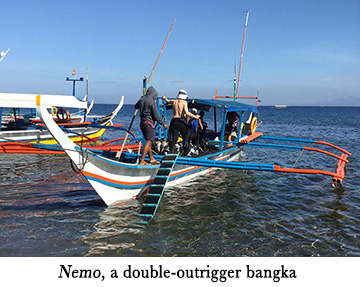 The waters of Anilao, a village two hours south of Manila, are said to be heaven on earth for muck diving, and after several trips there, I agree. So when I read Undercurrent subscriber Pat Sinclair's online reader report about APA, I knew we had to try it. While I'm not an underwater photographer, I enjoy spotting and IDing critters, while El can remain patiently in place for half a dive to get the best shot and wanted to update his photography skills. So we booked a seven-day trip in May.
The waters of Anilao, a village two hours south of Manila, are said to be heaven on earth for muck diving, and after several trips there, I agree. So when I read Undercurrent subscriber Pat Sinclair's online reader report about APA, I knew we had to try it. While I'm not an underwater photographer, I enjoy spotting and IDing critters, while El can remain patiently in place for half a dive to get the best shot and wanted to update his photography skills. So we booked a seven-day trip in May.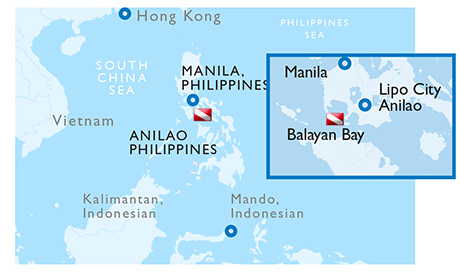 We made several dives at Sim Sim (the guides call it that because all the dives are similar), a 45-minute bouncing ride from APA (our longest one). But with little to no current, it was easy to moor close to shore, where Jason helped me with my gear. I back-rolled into the 80°F water and dropped to the sandy bottom at 15 feet in murky, 20-foot visibility. Dropping down, my critter-spotting included a pregnant seahorse, a melibe coralophilia (nudibranch), some hairy frogfish, and a coconut octopus. Additionally, I spotted flamboyant cuttlefish, mimic octopus, small ghost pipefish, plenty of nudibranchs, and got a kick out of watching juvenile rockmovers. Between the two morning dives, Jason handed me a spicy hot ginger tea and buns with a fig-like filling. The boat had no head, nor first first-aid kit or emergency oxygen, but there were several nearby resorts.
We made several dives at Sim Sim (the guides call it that because all the dives are similar), a 45-minute bouncing ride from APA (our longest one). But with little to no current, it was easy to moor close to shore, where Jason helped me with my gear. I back-rolled into the 80°F water and dropped to the sandy bottom at 15 feet in murky, 20-foot visibility. Dropping down, my critter-spotting included a pregnant seahorse, a melibe coralophilia (nudibranch), some hairy frogfish, and a coconut octopus. Additionally, I spotted flamboyant cuttlefish, mimic octopus, small ghost pipefish, plenty of nudibranchs, and got a kick out of watching juvenile rockmovers. Between the two morning dives, Jason handed me a spicy hot ginger tea and buns with a fig-like filling. The boat had no head, nor first first-aid kit or emergency oxygen, but there were several nearby resorts.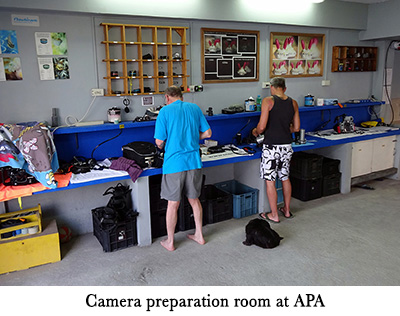 Wayne and his wife Rina joined Tim Ho, who is Chinese, in his dream of creating an academy for photographers. Rina smoothly handles the business side, and all three conduct the workshops. They are in the 35 to 45-year-old range, fit, and when not working with photographers, could be found in the water. Wayne is the more laid-back one, always ready to engage, and doesn't say no to an evening drink. Tim Ho is energetic, has an extraordinary eye for clients' needs, plays the guitar, and sings beautifully. Rina exhibits quiet enthusiasm and never misses a detail.
Wayne and his wife Rina joined Tim Ho, who is Chinese, in his dream of creating an academy for photographers. Rina smoothly handles the business side, and all three conduct the workshops. They are in the 35 to 45-year-old range, fit, and when not working with photographers, could be found in the water. Wayne is the more laid-back one, always ready to engage, and doesn't say no to an evening drink. Tim Ho is energetic, has an extraordinary eye for clients' needs, plays the guitar, and sings beautifully. Rina exhibits quiet enthusiasm and never misses a detail.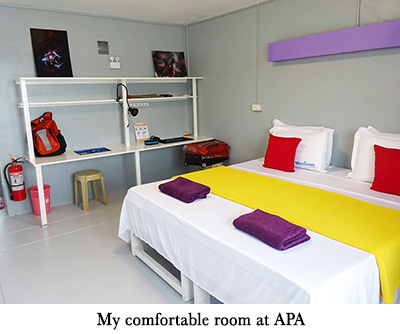 At Arthur's Wall, I spotted what I thought
was all-white spiky coral, but it was an inch-long
nudi, a Koehler's phyllodesmium, and I wondered
what else I had missed. Another major comeuppance
was near the house reef when I bypassed a small
clump of torn white toilet paper. When Jason corralled
El for photos, I realized it was a nudi I
had never seen before -- the translucent body of
this two-inch Melibe engeli seemed to be holding a
while skeleton together.
At Arthur's Wall, I spotted what I thought
was all-white spiky coral, but it was an inch-long
nudi, a Koehler's phyllodesmium, and I wondered
what else I had missed. Another major comeuppance
was near the house reef when I bypassed a small
clump of torn white toilet paper. When Jason corralled
El for photos, I realized it was a nudi I
had never seen before -- the translucent body of
this two-inch Melibe engeli seemed to be holding a
while skeleton together.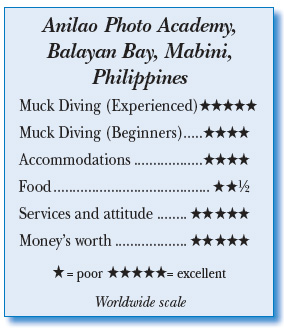 Unable to dive, I was jealous when Wayne expounded upon the thrill of "black
water diving," offshore deep-water diving, where he lowers lights and divers with
cameras ready roam freely, following planktonic creatures. Fascinating me most
among his many interesting shots were the paper nautilus (a pelagic octopus),
larval lobster hooked onto a jellyfish, and a ribbon eel. This black water photography
helped Wayne get this year's "Photographer of the Year" award at the Asia
Dive Expo. Oh well, next time.
Unable to dive, I was jealous when Wayne expounded upon the thrill of "black
water diving," offshore deep-water diving, where he lowers lights and divers with
cameras ready roam freely, following planktonic creatures. Fascinating me most
among his many interesting shots were the paper nautilus (a pelagic octopus),
larval lobster hooked onto a jellyfish, and a ribbon eel. This black water photography
helped Wayne get this year's "Photographer of the Year" award at the Asia
Dive Expo. Oh well, next time. Divers Compass: I paid $1,310 for eight nights, seven days of three-tank diving, and meals; because I missed three days' diving, they lowered it to $987 . . . I made reservations with Rina:
Divers Compass: I paid $1,310 for eight nights, seven days of three-tank diving, and meals; because I missed three days' diving, they lowered it to $987 . . . I made reservations with Rina: 